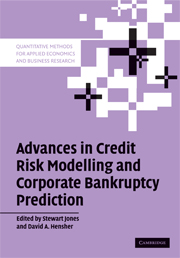Book contents
- Frontmatter
- Contents
- List of figures
- List of tables
- List of contributors
- Introduction
- 1 A statistical model for credit scoring
- 2 Mixed logit and error component models of corporate insolvency and bankruptcy risk
- 3 An evaluation of open- and closed-form distress prediction models: The nested logit and latent class models
- 4 Survival analysis and omitted dividends
- 5 Non-parametric methods for credit risk analysis: Neural networks and recursive partitioning techniques
- 6 Bankruptcy prediction and structural credit risk models
- 7 Default recovery rates and LGD in credit risk modelling and practice: An updated review of the literature and empirical evidence
- 8 Credit derivatives: Current practices and controversies
- 9 Local government distress in Australia: A latent class regression analysis
- 10 A belief-function perspective to credit risk assessments
- Index
Introduction
Introduction
Published online by Cambridge University Press: 11 June 2010
- Frontmatter
- Contents
- List of figures
- List of tables
- List of contributors
- Introduction
- 1 A statistical model for credit scoring
- 2 Mixed logit and error component models of corporate insolvency and bankruptcy risk
- 3 An evaluation of open- and closed-form distress prediction models: The nested logit and latent class models
- 4 Survival analysis and omitted dividends
- 5 Non-parametric methods for credit risk analysis: Neural networks and recursive partitioning techniques
- 6 Bankruptcy prediction and structural credit risk models
- 7 Default recovery rates and LGD in credit risk modelling and practice: An updated review of the literature and empirical evidence
- 8 Credit derivatives: Current practices and controversies
- 9 Local government distress in Australia: A latent class regression analysis
- 10 A belief-function perspective to credit risk assessments
- Index
Summary
Credit risk and corporate bankruptcy prediction research has been topical now for the better part of four decades, and still continues to attract fervent interest among academics, practitioners and regulators. In recent years, the much-publicized collapse of many large global corporations, including Enron, Worldcom, Global Crossing, Adelphia Communications, Tyco, Vivendi, Royal Ahold, HealthSouth, and, in Australia, HIH, One.Tel, Pasminco and Ansett (just to mention a few), has highlighted the significant economic, social and political costs associated with corporate failure. Just as it seemed these events were beginning to fade in the public memory, disaster struck again in June 2007. The collapse of the ‘sub-prime’ mortgage market in the United States, and the subsequent turmoil in world equity and bond markets has led to fears of an impending international liquidity and credit crisis, which could affect the fortunes of many financial institutions and corporations for some time to come.
These events have tended to reignite interest in various aspects of corporate distress and credit risk modelling, and more particularly the credit ratings issued by the Big Three ratings agencies (Standard and Poor's, Moody's and Fitches). At the time of the Enron and Worldcom collapses, the roles and responsibilities of auditors were the focus of public attention. However, following the sub-prime collapse, credit-rating agencies have been in the spotlight. At the heart of the sub-prime scandal have been the credit ratings issued for many collateralized debt obligations (CDOs), particularly CDOs having a significant exposure to the sub-prime lending market.
- Type
- Chapter
- Information
- Publisher: Cambridge University PressPrint publication year: 2008
- 1
- Cited by



